Jake's TV Experiences
Of all the wonderful kids' TV shows I have enjoyed over the years, including the six on Rosey's list, the four outlined below are the ones that I have been inspired by the most, and will always particularly love.
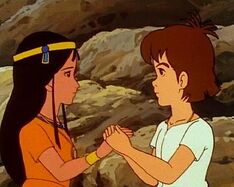 © Studio Pierrot and DIC Entertainment, 1982
© Studio Pierrot and DIC Entertainment, 1982
The Mysterious Cities of Gold (1982-1983)
When I first ventured into the extensive world of internet TV nostalgia, The Mysterious Cities of Gold was a show that I saw mentioned again and again as a televisual masterpiece without equal. I used to have very vague memories of watching it when I was about six years old (during Children's BBC's repeat run in 1989, as it turned out) and I remembered that I had enjoyed it a lot. Some time during the summer of 2006, my curiosity about just how good the show actually was came to a head, and I watched the whole series on YouTube. What was my eventual verdict? The Mysterious Cities of Gold is a televisual masterpiece without equal!
The Mysterious Cities of Gold is brilliantly, lovingly and beautifully made in a style all of its own; it is not quite true anime, but it is a long way from the traditional western style too. The background music really is magical, and conjures up so many different emotions at different points in the story. The show has more depth than I have ever found in any other piece of artistic expression, all incredibly subtly done.
I absolutely love the friendship between the three young protagonists, Esteban, Zia and Tao, which is so simple and honest, yet so terribly effective at achieving all kinds of great things. The kids are always loyal, compassionate, just and true, unlike most of the adults in the series. The powerful yet subtle romantic relationship between Zia and Esteban (pictured above) is the strongest and most interesting aspect of the series for me, followed closely by the multifaceted (though certainly not romantic!) relationship between Esteban and Mendoza, the main adult character. Special praise goes out to Canadian one-time voice actor Shiraz Adam, who was ten years old when he voiced Esteban, and gave both the character and the show more heart and soul than should really be humanly possible.
When I first ventured into the extensive world of internet TV nostalgia, The Mysterious Cities of Gold was a show that I saw mentioned again and again as a televisual masterpiece without equal. I used to have very vague memories of watching it when I was about six years old (during Children's BBC's repeat run in 1989, as it turned out) and I remembered that I had enjoyed it a lot. Some time during the summer of 2006, my curiosity about just how good the show actually was came to a head, and I watched the whole series on YouTube. What was my eventual verdict? The Mysterious Cities of Gold is a televisual masterpiece without equal!
The Mysterious Cities of Gold is brilliantly, lovingly and beautifully made in a style all of its own; it is not quite true anime, but it is a long way from the traditional western style too. The background music really is magical, and conjures up so many different emotions at different points in the story. The show has more depth than I have ever found in any other piece of artistic expression, all incredibly subtly done.
I absolutely love the friendship between the three young protagonists, Esteban, Zia and Tao, which is so simple and honest, yet so terribly effective at achieving all kinds of great things. The kids are always loyal, compassionate, just and true, unlike most of the adults in the series. The powerful yet subtle romantic relationship between Zia and Esteban (pictured above) is the strongest and most interesting aspect of the series for me, followed closely by the multifaceted (though certainly not romantic!) relationship between Esteban and Mendoza, the main adult character. Special praise goes out to Canadian one-time voice actor Shiraz Adam, who was ten years old when he voiced Esteban, and gave both the character and the show more heart and soul than should really be humanly possible.
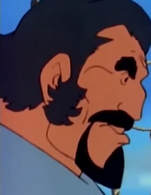 © Studio Pierrot and DIC Entertainment, 1982
© Studio Pierrot and DIC Entertainment, 1982
EGB Comparison
The Mysterious Cities of Gold draws on many science-fiction elements, but it never quite spills over into the realms of fantasy... not that I'm prepared to make a judgement about which of those categories is the better fit for Ghostbusters!
The main link between The Mysterious Cities of Gold and Ghostbusters is actually our fanfiction, as both franchises have now definitively been shown to exist in the same continuity. Captain Gaspar (pictured right) is one of the main antagonists in The Mysterious Cities of Gold, but what that particular series does not make clear is that Gaspar went on to settle down with a Mayan woman on the Mexican island of Cozumel, and that the happy couple turned out to be direct ancestors of the Rivera family. A specific point of interest is that Captain Gaspar passed something quite striking down the genetic line, namely what has become known as 'the Gaspar nose'. This particular nose can clearly be discerned on many of Captain Gaspar's descendants, including Carl, Eduardo and Kevin Rivera.
The Mysterious Cities of Gold draws on many science-fiction elements, but it never quite spills over into the realms of fantasy... not that I'm prepared to make a judgement about which of those categories is the better fit for Ghostbusters!
The main link between The Mysterious Cities of Gold and Ghostbusters is actually our fanfiction, as both franchises have now definitively been shown to exist in the same continuity. Captain Gaspar (pictured right) is one of the main antagonists in The Mysterious Cities of Gold, but what that particular series does not make clear is that Gaspar went on to settle down with a Mayan woman on the Mexican island of Cozumel, and that the happy couple turned out to be direct ancestors of the Rivera family. A specific point of interest is that Captain Gaspar passed something quite striking down the genetic line, namely what has become known as 'the Gaspar nose'. This particular nose can clearly be discerned on many of Captain Gaspar's descendants, including Carl, Eduardo and Kevin Rivera.
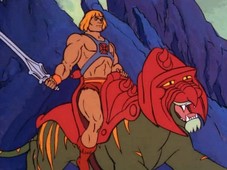 © Filmation, 1983
© Filmation, 1983
He-Man and the Masters of the Universe (1983-1985)
I will always associate He-Man with holiday mornings. ITV certainly knew how to get me out of bed early when school was out – He-Man followed by Inspector Gadget and then Vicky the Viking. He-Man was always by far my favourite, not just of those three shows but of everything that was on TV at the time. I acquired a huge collection of second-hand action figures from a local shop that sold hand-me-down toys and clothes; the Masters of the Universe craze was well and truly over in the wider world by that time, and there was a seemingly never-ending supply of unwanted action figures for me to choose from. I had activity books, annuals, tie-in story books and cassette tapes. In other words, I was mad on He-Man, and in many ways I still am!
He-Man and the Masters of the Universe worked so well because it was basically a character-driven show. Because it concentrated on only a few characters at a time, it was always very effectively done. Some episodes were carried off quite brilliantly without much of a plot and no villains in them whatsoever. An episode I always remembered (entitled 'Not So Blind') involves He-Man and Ram-Man taking a blind child on a little excursion, and becoming temporarily blind themselves after an accident. Thanks to their experiences, the two heroes – and all of us at home – learn a valuable lesson about how being disabled is not the same thing as being helpless, and that everyone is intelligent and useful in their own way. Yes – it's trite, it's clichéd, it's in-your-face, but it's done incredibly well and it really is a brilliant piece of television.
He-Man and the Masters of the Universe is a very obvious attempt to entice us to buy action figures and play-sets, but it is also an engaging show with plenty of depth that executive producer Lou Scheimer and his friends at Filmation obviously put a lot of time, effort and love into. I still get that little thrill when I hear 'By the Power of Grayskull!' booming out of the TV and I hope I always will, because He-Man was a big part of my childhood, and the childhoods of so many children of the '80s, and I think it deserves a lot of respect for that.
EGB Comparison
He-Man makes extensive use of both the science-fiction and fantasy genres, and is certainly not averse to including a ghost or two from time to time. My favourite link between the two franchises, however, is the very well-delivered line from Ghostbusters II, 'I thought it was gonna be He-Man!', as whenever I used to watch The Real Ghostbusters (or, indeed, any cartoon that wasn't He-Man) I always knew I'd much rather be watching He-Man instead!
I will always associate He-Man with holiday mornings. ITV certainly knew how to get me out of bed early when school was out – He-Man followed by Inspector Gadget and then Vicky the Viking. He-Man was always by far my favourite, not just of those three shows but of everything that was on TV at the time. I acquired a huge collection of second-hand action figures from a local shop that sold hand-me-down toys and clothes; the Masters of the Universe craze was well and truly over in the wider world by that time, and there was a seemingly never-ending supply of unwanted action figures for me to choose from. I had activity books, annuals, tie-in story books and cassette tapes. In other words, I was mad on He-Man, and in many ways I still am!
He-Man and the Masters of the Universe worked so well because it was basically a character-driven show. Because it concentrated on only a few characters at a time, it was always very effectively done. Some episodes were carried off quite brilliantly without much of a plot and no villains in them whatsoever. An episode I always remembered (entitled 'Not So Blind') involves He-Man and Ram-Man taking a blind child on a little excursion, and becoming temporarily blind themselves after an accident. Thanks to their experiences, the two heroes – and all of us at home – learn a valuable lesson about how being disabled is not the same thing as being helpless, and that everyone is intelligent and useful in their own way. Yes – it's trite, it's clichéd, it's in-your-face, but it's done incredibly well and it really is a brilliant piece of television.
He-Man and the Masters of the Universe is a very obvious attempt to entice us to buy action figures and play-sets, but it is also an engaging show with plenty of depth that executive producer Lou Scheimer and his friends at Filmation obviously put a lot of time, effort and love into. I still get that little thrill when I hear 'By the Power of Grayskull!' booming out of the TV and I hope I always will, because He-Man was a big part of my childhood, and the childhoods of so many children of the '80s, and I think it deserves a lot of respect for that.
EGB Comparison
He-Man makes extensive use of both the science-fiction and fantasy genres, and is certainly not averse to including a ghost or two from time to time. My favourite link between the two franchises, however, is the very well-delivered line from Ghostbusters II, 'I thought it was gonna be He-Man!', as whenever I used to watch The Real Ghostbusters (or, indeed, any cartoon that wasn't He-Man) I always knew I'd much rather be watching He-Man instead!
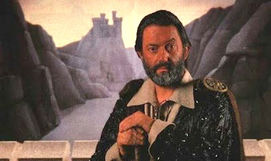 © Anglia Television, 1989
© Anglia Television, 1989
Knightmare (1987-1994)
When I was four and a half, Knightmare usurped He-Man as my favourite TV show. It was designed and marketed as a living computer game, although it actually turned out to be something much more than that: a truly immersive, truly interactive medieval fantasy game show for young teenaged contestants. It pioneered the use of blue-screen technology, and was hugely popular on CITV throughout its eight-season run.
One of the very special things about the show was that it aired (from its third series onwards) on Friday afternoons, providing a very exciting, very highly anticipated end to the week after yet another long slog at school. It was presented throughout by Hugo Myatt as Treguard the Dungeon Master (pictured right), who has justly earned his place as an icon of British children's television. Hugo even appeared in the two online reunion episodes of Knightmare in 2004 and 2013, thus ensuring that they were not completely unwatchable.
EGB Comparison
As a fantasy show that used a castle dungeon for its game-play setting, Knightmare had more than its fair share of ghosts. Much as I loved Knightmare when I was four and five years old, I was frequently scared by it too. I was especially frightened by a particular type of ghost called a cavern-wraith, which was designed very much in the white sheet vein. Conversely, I was never really scared by The Real Ghostbusters at that time because I found the ghosts really goofy and not at all frightening. The single exception I remember is the episode entitled 'Dairy Farm', which I know I was slightly unnerved by.
It is also worth noting that Rosey's experiences with Extreme Ghostbusters and Danny Phantom very much parallel my own with Knightmare and a CBBC game show from the early part of this century called Raven, as I was moved to remark when I first read Rosey's I Also Like. Just like Rosey with Danny Phantom, I was nineteen years old when I first saw Raven, and was reminded of my favourite TV show from childhood in a way that I would no longer have thought possible.
When I was four and a half, Knightmare usurped He-Man as my favourite TV show. It was designed and marketed as a living computer game, although it actually turned out to be something much more than that: a truly immersive, truly interactive medieval fantasy game show for young teenaged contestants. It pioneered the use of blue-screen technology, and was hugely popular on CITV throughout its eight-season run.
One of the very special things about the show was that it aired (from its third series onwards) on Friday afternoons, providing a very exciting, very highly anticipated end to the week after yet another long slog at school. It was presented throughout by Hugo Myatt as Treguard the Dungeon Master (pictured right), who has justly earned his place as an icon of British children's television. Hugo even appeared in the two online reunion episodes of Knightmare in 2004 and 2013, thus ensuring that they were not completely unwatchable.
EGB Comparison
As a fantasy show that used a castle dungeon for its game-play setting, Knightmare had more than its fair share of ghosts. Much as I loved Knightmare when I was four and five years old, I was frequently scared by it too. I was especially frightened by a particular type of ghost called a cavern-wraith, which was designed very much in the white sheet vein. Conversely, I was never really scared by The Real Ghostbusters at that time because I found the ghosts really goofy and not at all frightening. The single exception I remember is the episode entitled 'Dairy Farm', which I know I was slightly unnerved by.
It is also worth noting that Rosey's experiences with Extreme Ghostbusters and Danny Phantom very much parallel my own with Knightmare and a CBBC game show from the early part of this century called Raven, as I was moved to remark when I first read Rosey's I Also Like. Just like Rosey with Danny Phantom, I was nineteen years old when I first saw Raven, and was reminded of my favourite TV show from childhood in a way that I would no longer have thought possible.
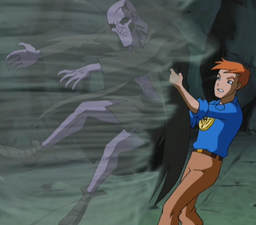 © Universal Cartoon Studios, 2003
© Universal Cartoon Studios, 2003
The Mummy: Quest for the Lost Scrolls/Secrets of the Medjai (2001-2003)
This animated series is based on the first two movies in the rebooted Mummy franchise, which were released in 1999 and 2001. This is not a very widely held opinion online, but I think the cartoon is far better than the movies. It is not perfect, of course; most of the plot is driven by MacGuffin artefacts, and its run-time of barely twenty minutes per episode does not allow for the level of depth and development that some of the characters are crying out for. However, as an action-based fantasy cartoon series, I feel that it has a whole lot going for it.
The main characters and the voice work are very well done. As the DVD cover promises, the show contains a lot of exciting family teamwork that is really great to watch, as well as some excellent emotional support between family members at appropriate moments. John Schneider does an excellent job as Rick, giving the character a pleasing Indiana Jones vibe. Grey DeLisle as Evy and Tom Kenny as Jonathan may not provide the best English accents ever, but their performances are always on-point. I do like what Jim Cummings does with Imhotep (pictured left, being given a thorough going-over by Alex), although I think it's a shame that he doesn't get very much chance to engage in appropriate banter with the good guys, and eventually becomes a completely redundant part of the show despite the fact that he is the title character.
What really makes me love this series is Alex, who is a fantastic hero and protagonist; I think the fact that the show becomes more and more the story of his journey is absolutely the right direction for it to take. Chris Marquette (who was aged sixteen and seventeen whilst playing Alex) gives an extremely engaging, charismatic and sensitive performance, and his changing voice perfectly mirrors Alex's extensive emotional and physical development. Alex has two main parts to his character: he is a typical kid and he is a great hero, underlining his undoubted status as a great kid hero. He is certainly my favourite kid hero of all time; I particularly like the way he accepts and embraces his destiny with fortitude and determination, despite the fact that he certainly does not always find it easy to fulfil.
The locations and guest characters are always well conceived and well used. My particular favourite secondary characters are Fadil and Yanit (pictured below, flanking Alex), whose continuing interactions and relationships with Alex constitute the most interesting unexplored aspect of the series in my opinion.
This animated series is based on the first two movies in the rebooted Mummy franchise, which were released in 1999 and 2001. This is not a very widely held opinion online, but I think the cartoon is far better than the movies. It is not perfect, of course; most of the plot is driven by MacGuffin artefacts, and its run-time of barely twenty minutes per episode does not allow for the level of depth and development that some of the characters are crying out for. However, as an action-based fantasy cartoon series, I feel that it has a whole lot going for it.
The main characters and the voice work are very well done. As the DVD cover promises, the show contains a lot of exciting family teamwork that is really great to watch, as well as some excellent emotional support between family members at appropriate moments. John Schneider does an excellent job as Rick, giving the character a pleasing Indiana Jones vibe. Grey DeLisle as Evy and Tom Kenny as Jonathan may not provide the best English accents ever, but their performances are always on-point. I do like what Jim Cummings does with Imhotep (pictured left, being given a thorough going-over by Alex), although I think it's a shame that he doesn't get very much chance to engage in appropriate banter with the good guys, and eventually becomes a completely redundant part of the show despite the fact that he is the title character.
What really makes me love this series is Alex, who is a fantastic hero and protagonist; I think the fact that the show becomes more and more the story of his journey is absolutely the right direction for it to take. Chris Marquette (who was aged sixteen and seventeen whilst playing Alex) gives an extremely engaging, charismatic and sensitive performance, and his changing voice perfectly mirrors Alex's extensive emotional and physical development. Alex has two main parts to his character: he is a typical kid and he is a great hero, underlining his undoubted status as a great kid hero. He is certainly my favourite kid hero of all time; I particularly like the way he accepts and embraces his destiny with fortitude and determination, despite the fact that he certainly does not always find it easy to fulfil.
The locations and guest characters are always well conceived and well used. My particular favourite secondary characters are Fadil and Yanit (pictured below, flanking Alex), whose continuing interactions and relationships with Alex constitute the most interesting unexplored aspect of the series in my opinion.
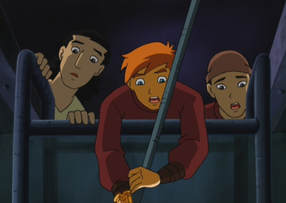 © Universal Cartoon Studios, 2003
© Universal Cartoon Studios, 2003
EGB Comparison
A pretty strong connection between the two series is the fact that they have some very significant shared writers. The Mummy was developed for television by 'Rage' writers Tom Pugsley and Greg Klein, and their main assistant writer was Steven Melching, who gave us 'In Your Dreams' and 'Glutton for Punishment'.
One of my absolute favourite episodes of The Mummy, 'Like Father Like Son', is very like 'Rage' in many ways, as both episodes deal – incredibly well and incredibly engagingly – with rather strained male family relationships. It's no surprise to see Tom and Greg's writing credit at the end of 'Like Father Like Son'; clearly they are highly skilled at creating complicated and compelling family dynamics between male characters.
While the relationships and dynamics certainly are not exactly the same, Alex in 'Like Father Like Son' is directly comparable to Kevin in many ways, while Rick takes on the role of Carl (if Carl wasn't a totally unreasonable jerk!) and Jack (Rick's father) has distinct shades of Eduardo, the black sheep of the family whose exciting lifestyle captivates the young boy, much to the dad's chagrin.
The series as a whole contains many monsters, spirits and other supernatural creatures, although there are no actual ghosts as such. The Order of the Medjai could be seen as having a similar role to that of the Ghostbusters, as both organisations are concerned with paranormal investigations and eliminations, and neither is exactly sanctioned by official authorities. I suppose Egon, in his role as mentor to the Extreme Ghostbusters, has something of a counterpart in Ardeth Bay of the Medjai, although Egon can certainly rest assured that he is the far better practitioner of this role, at least in my opinion.
A pretty strong connection between the two series is the fact that they have some very significant shared writers. The Mummy was developed for television by 'Rage' writers Tom Pugsley and Greg Klein, and their main assistant writer was Steven Melching, who gave us 'In Your Dreams' and 'Glutton for Punishment'.
One of my absolute favourite episodes of The Mummy, 'Like Father Like Son', is very like 'Rage' in many ways, as both episodes deal – incredibly well and incredibly engagingly – with rather strained male family relationships. It's no surprise to see Tom and Greg's writing credit at the end of 'Like Father Like Son'; clearly they are highly skilled at creating complicated and compelling family dynamics between male characters.
While the relationships and dynamics certainly are not exactly the same, Alex in 'Like Father Like Son' is directly comparable to Kevin in many ways, while Rick takes on the role of Carl (if Carl wasn't a totally unreasonable jerk!) and Jack (Rick's father) has distinct shades of Eduardo, the black sheep of the family whose exciting lifestyle captivates the young boy, much to the dad's chagrin.
The series as a whole contains many monsters, spirits and other supernatural creatures, although there are no actual ghosts as such. The Order of the Medjai could be seen as having a similar role to that of the Ghostbusters, as both organisations are concerned with paranormal investigations and eliminations, and neither is exactly sanctioned by official authorities. I suppose Egon, in his role as mentor to the Extreme Ghostbusters, has something of a counterpart in Ardeth Bay of the Medjai, although Egon can certainly rest assured that he is the far better practitioner of this role, at least in my opinion.

